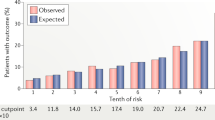Abstract
The pathobiology of aortic stenosis (AS) now is recognized to have many similiarities to that of atherosclerosis, a disease in which lipid lowering therapy with statin drugs has been successful. Accordingly statins have been used to attempt to retard the progression of AS with variable success. The SEAS trial compared the effects of the combination of simvastatin and ezetimibe to placebo in retarding the progression of aortic stenosis (AS) and was the largest randomized trial of such therapies. One thousand eight hundred seventy three patients with moderate AS were included. The group receiving the drugs had a large reduction in LDL cholesterol and a reduction in coronary events. However drug therapy had no effect on the progression of AS. Conclusion. While AS has many similarities to atherosclerosis, lipid lowering therapy does not affect progression of moderate to severe AS.

Similar content being viewed by others
References
Bonow R, Carabello BA, Chatterjee K, et al.: ACC/AHA 2006 guidelines for the management of patients with valvular heart disease: a report of the American College of Cardiology/American Heart Association task force on practice guidelines (writing committee to revise the 1998 guidelines for the management of patients with valvular heart disease). Circulation 2006, 114:e84–e231.
Rossebo AB, Pederson TR, Boman K, et al.: Intensive lipid lowering with simvastatin and ezetimibe in aortic stenosis. SEAS Investigators. N Engl J Med 2008, 359:1343–1356.
Otto CM, Kuusisto J, Reichenback DD, et al.: Characterization of the early lesion of ‘degenerative’ valvular aortic stenosis. Histological and immunohistochemical studies. Circulation 1993, 90:844–853.
Otto CM, Lind BK, Kitzman DW, et al.: Association of aortic-valve sclerosis with cardiovascular mortality and morbidity in the elderly. N Engl J Med 1999, 341:142–147.
Chandra HR, Goldstein JA, Choudhary N, et al.: Adverse outcome in aortic sclerosis is associated with coronary artery disease and inflammation. J Am Coll Cardiol 2004, 43:169–175.
Stewart BF, Siscovick D, Lind BK, et al.: Clinical factors associated with calcific aortic valve disease: Cardiovascular Health Study. J Am Coll Cardiol 1997, 29:630–634.
Chui MC, Newby DE, Panarelli M, et al.: Association between calcific aortic stenosis and hypercholesterolemia: is there a need for a randomized controlled trial of cholesterol-lowering therapy? Clin Cardiol 2001, 24:52–55.
Aronow WS, Ahn C, Kronzon I, Goldman ME: Association of coronary risk factors and use of statins with progression of mild valvular aortic stenosis in older persons. Am J Cardiol 2001, 88:693–695.
Pohle K, Maffert R, Ropers D, et al.: Progression of aortic valve calcification: association with coronary atherosclerosis and cardiovascular factors. Circulation 2001, 104:1927–1932.
Novaro GM, Tiong IY, Pearce GL, et al.: Effect of hydroxymethylglutaryl coenzyme a reductase inhibitors on the progression of calcific aortic stenosis. Circulation 2001, 104:2205–2209.
Moura LM, Ramos SF, Zamorano JL, et al.: Rosuvastatin affecting aortic valve endothelium to slow progression of aortic stenosis. J Am Coll Cardiol 2007, 49:554–561.
Cowell SJ, Newby DE, Prescott RJ, et al.: A randomized trial of intensive lipid-lowering therapy in calcific aortic stenosis. N Engl J Med 2005, 352:2389–2397.
Toutouzas K, Drakopoulou M, Synetos A, et al.: In vivo aortic valve thermal heterogeneity in patients with non-rheumatic aortic valve stenosis: first in vivo experience in humans. J Am Coll Cardiol 2008, 52:758–763.
Rajamannan NM, Subramaniam M, Stock SR, et al.: Atorvastatin inhibits calcification and enhances nitric oxide synthase production in the hypercholesterolaemic aortic valve. Heart 2005, 91:806–810.
Garg V, Muth AN, Ransom JF, et al.: Mutations in NOTCH1 cause aortic valve disease. Nature 2005, 437:270–274.
Goldbarg SH, Elmariah S, Miller MA, Fuster V: Insights into degenerative aortic valve disease. J Am Coll Cardiol 2007, 50:1205–1213.
Disclosure
No potential conflict of interest relevant to this article was reported.
Author information
Authors and Affiliations
Corresponding author
Rights and permissions
About this article
Cite this article
Carabello, B.A. The SEAS Trial. Curr Cardiol Rep 12, 122–124 (2010). https://doi.org/10.1007/s11886-010-0094-9
Published:
Issue Date:
DOI: https://doi.org/10.1007/s11886-010-0094-9




